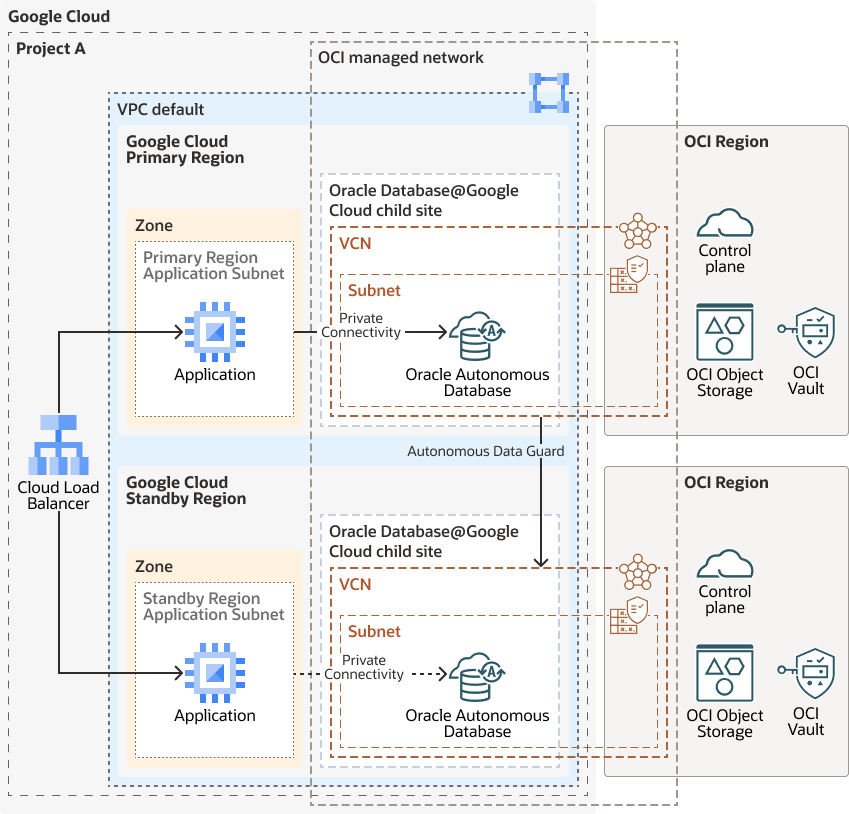Deploy an Oracle Autonomous Database in Oracle Database@Google Cloud
Architecture
This architecture describes some best practices for deploying an Oracle Autonomous Database in Oracle Database@Google Cloud in multiple regions using Oracle Autonomous Data Guard.
Business continuity practices and high-availability topologies should always be considered when designing mission-critical database applications. The architecture diagram shows an application running in two Google Cloud Regions. Users access the application externally through a Google Cloud Load Balancer. Optionally, the Autonomous Database can be configured to have a primary database running in the primary region and a standby database running in the secondary region. In the unlikely event of a Google Cloud Region failure, the standby database in the secondary region can be activated and can become the primary database to serve the application.
The application accesses the database through a private connection to the Oracle Database@Google Cloud subnet. If cross-region business continuity is required, Oracle Autonomous Data Guard can optionally be enabled. If Oracle Autonomous Data Guard is enabled, then Oracle will automatically create a standby database in another Google Cloud Region. Oracle Autonomous Data Guard keeps the primary database and cross-region standby in sync so that the standby database can be activated with minimal data loss in the case of a primary region outage. Oracle-managed automatic backups are always enabled by default.
The following diagram illustrates this reference architecture.

Description of the illustration adb-oracle-db-google-cloud-region.png
adb-oracle-db-google-cloud-region-oracle.zip
The architecture has the following components:
- Region
An Oracle Cloud Infrastructure (OCI) or Google Cloud Region is a localized geographic area that contains one or more data centers. Regions are independent of one another and are in many countries across multiple continents.
In regions where the Oracle Database@Google Cloud services are available, a Google Cloud Region is connected to an OCI Region, with Google Cloud availability zones (AZs) inter-connected to corresponding OCI availability domains (ADs). - Google Availability Zone
An availability zone is a physically separate data center within a region designed to be available and fault-tolerant. It is close enough to have low-latency connections to other availability zones.
- Google Cloud Project
A Google Cloud Project is required to use Google Workspace APIs and build Google Workspace add-ons or apps. A Cloud project forms the basis for creating, enabling, and using all Google Cloud services, including managing APIs, enabling billing, adding and removing collaborators, and managing permissions.
- Google Virtual Private Cloud
Google Cloud Virtual Private Cloud (VPC) provides networking functionality to Compute Engine virtual machine (VM) instances, Google Kubernetes Engine (GKE) containers, database services, and serverless workloads. VPC provides global, scalable, and flexible networking for your cloud-based service.
- Google Subnets
Each VPC network consists of one or more IP address ranges called subnets. Subnets are regional resources that have IP address ranges associated with them.
- Google Load Balancer
Google Load Balancer provides automated traffic distribution from a single entry point to multiple servers in the back end.
- Autonomous Data Guard
Oracle Autonomous Data Guard enables a standby (peer) database to provide data protection and disaster recovery for your Autonomous Database instance. It provides a comprehensive set of services that create, maintain, manage, and monitor one or more standby databases to enable production Oracle databases to remain available without interruption. Oracle Data Guard maintains these standby databases as copies of the production database. Then, if the production database becomes unavailable because of a planned or an unplanned outage, you can switch any standby database to the production role, minimizing the downtime associated with the outage.
- Object storage
OCI Object Storage provides access to large amounts of structured and unstructured data of any content type, including database backups, analytic data, and rich content such as images and videos. You can safely and securely store data directly from the internet or from within the cloud platform. You can scale storage without experiencing any degradation in performance or service reliability.
Use standard storage for "hot" storage that you need to access quickly, immediately, and frequently. Use archive storage for "cold" storage that you retain for long periods of time and seldom or rarely access.
- Oracle Cloud Infrastructure Vault
Oracle Cloud Infrastructure Vault enables you to create and centrally manage the encryption keys that protect your data and the secret credentials that you use to secure access to your resources in the cloud. The default key management is Oracle-managed keys. You can also use customer-managed keys which use OCI Vault. OCI Vault offers a rich set of REST APIs to manage vaults and keys.
Considerations
When implementing this architecture, consider the following:
- Network Connectivity
When using private connectivity, plan your network connectivity in advance to define your network address space (CIDR) and topologies. You need at least one VPC that you can pair with a corresponding OCI Virtual Cloud Network (VCN). The CIDR blocks for any Google Cloud VPCs and OCI VCNs must not overlap.
- Application Resiliency
If using a cross-region standby, then the application tier should also have cross-region redundancy with Google Cloud Global Load Balancer for quick failover.
- Disaster Recovery Testing
Test your disaster recovery setup by performing a switchover to the standby database on a regular cadence to ensure operational excellence.